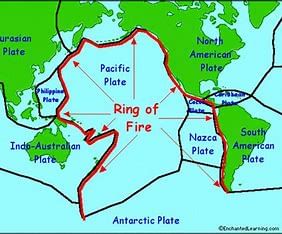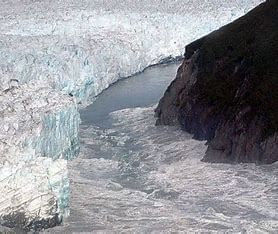UPSC Daily Current Affairs- 4th April 2024 | Current Affairs & Hindu Analysis: Daily, Weekly & Monthly PDF Download
| Table of contents |

|
| GS-I |

|
| Ring of Fire |

|
| Indian Laurel Tree |

|
| Glacial Lake Floods |

|
| GS-II |

|
| Sainik Schools |

|
| Postal Ballot |

|
| GS-III |

|
| Pelagia noctiluca |

|
| Atomic Clocks |

|
| Carbon Fibre Overview |

|
GS-I
Ring of Fire
Subject: Geography

Why in News?
Nine individuals lost their lives, and over 800 sustained injuries in Taiwan following the most significant earthquake to hit the island in a minimum of 25 years.
Background
- Taiwan is highly susceptible to earthquakes because it is situated along the Pacific "Ring of Fire," where around 90% of the world's earthquakes occur.
- Since 1980, the island and its surrounding waters have experienced approximately 2,000 earthquakes with a magnitude of 4.0 or higher, along with over 100 earthquakes exceeding a magnitude of 5.5.
Overview of Ring of Fire
- The Ring of Fire is a vast zone with numerous volcanoes and earthquake sites that extends along the Pacific Ocean.
- It takes on a semi-circular or horseshoe shape, covering a distance of nearly 40,250 kilometers.
- This region delineates the intersections of multiple tectonic plates, such as the Eurasian, North American, Juan de Fuca, Cocos, Caribbean, Nazca, Antarctic, Indian, Australian, Philippine plates, and other smaller plates, all surrounding the significant Pacific Plate.
- It traverses through an additional 15 countries, including the USA, Indonesia, Mexico, Japan, Canada, Guatemala, Russia, Chile, Peru, and the Philippines.
Earthquake Vulnerability
- The high frequency of earthquakes in the Ring of Fire is attributed to the continuous movements of tectonic plates, which slide past, collide with, or move above or below each other.
- Due to the rough edges of these plates, they become stuck with one another while the remainder of the plate continues its motion, resulting in an earthquake when the plate shifts significantly enough for the edges to unstick at a fault line.
- Specifically, Taiwan encounters earthquakes due to the interactions between two tectonic plates: the Philippine Sea Plate and the Eurasian Plate.
Volcanic Activity
- The presence of numerous volcanoes in the Ring of Fire is also a consequence of tectonic plate movements.
- Many volcanoes are formed through a process called subduction, where two plates collide, leading to one plate being pushed beneath the other, creating a deep trench.
- Subduction occurs when an oceanic plate, like the Pacific Plate, is forced into a hotter mantle plate, resulting in heating, mixing of volatile elements, magma production, and subsequent volcanic formation.
- The magma rises through the overlying plate and eventually erupts at the surface, giving rise to volcanoes.
Source: Indian Express
Indian Laurel Tree
Subject: Geography

Why in News?
Recently, forest department authorities in Andhra Pradesh's Alluri Sitharama Raju district cut the bark of an Indian laurel tree, resulting in the outflow of water.
About the Indian Laurel Tree:
- Scientific name: Terminalia elliptica (also known as T. tomentosa)
- Other names: Asna, saj or saaj, Indian laurel, marutham (Tamil), matti (Kannada), ain (Marathi), taukkyan (Burma), asana (Sri Lanka), and colloquially known as crocodile bark due to its bark pattern.
- Habitat: Primarily found in both dry and moist deciduous forests in southern India up to 1000 meters.
- Distribution: Native to southern and Southeast Asia, including countries like India, Nepal, Bangladesh, Myanmar, Thailand, Laos, Cambodia, and Vietnam.
Applications:
- The wood of the Indian Laurel Tree is utilized in various ways such as for furniture, cabinetwork, joinery, paneling, specialty items, boat-building, railroad cross-ties (treated), decorative veneers, and musical instruments like guitar fretboards.
- Its leaves serve as food for Antheraea paphia (silkworms) which produce tussar silk, a commercially important wild silk variety.
- The bark is used medicinally to treat diarrhea, and it can also yield oxalic acid.
- The bark and fruit are a source of pyrogallol and catechol used in dyeing and tanning leather.
Source: The Hindu
Glacial Lake Floods
Subject: Geography

Why in News?
The Uttarakhand government has formed expert teams to assess the risks posed by five dangerous glacial lakes in the region.
- These lakes are prone to Glacial Lake Outburst Floods (GLOFs), which have caused disasters in the Himalayan states recently.
Glacial Lake Outburst Floods (GLOFs)
- Definition and Formation
- Glacial lakes are sizable water bodies situated in front of, on top of, or beneath a melting glacier.
- They form when meltwater fills depressions left behind as glaciers retreat.
- These lakes are common in high-altitude or polar regions with glaciers.
- Types of Glacial Lakes
- Ice-contact lakes: These have glacier ice ending in the lake.
- Distal lakes: Located away from glaciers but still influenced by them.
- Causes and Impacts of GLOFs
- Triggering Factors
- GLOFs can be prompted by events like glacial calving or avalanches leading to the destabilization of the lake boundary.
- Destructive Consequences
- GLOFs can release large amounts of water, sediment, and debris downstream, causing extensive damage to infrastructure and endangering lives.
- Triggering Factors
- Significance of GLOFs
- The rise in GLOF incidents in the Himalayan region is attributed to climate change-induced glacier melting and rapid development in vulnerable areas.
- A study highlighted the risk faced by millions in India and Pakistan due to GLOFs, despite having fewer and smaller glacial lakes compared to other regions.
- Risk Assessment and Mitigation
- Objective: The aim of risk assessment is to reduce the likelihood of GLOF events and enhance preparedness for relief and evacuation.
- Findings: The National Disaster Management Authority has pinpointed 188 potentially hazardous glacial lakes in the Himalayan states, with 13 in Uttarakhand, susceptible to breaches during heavy rainfall.
Source: Indian Express
GS-II
Sainik Schools
Subject: Polity and Governance

Why in News?
The Defence Ministry clarified that the political or ideological stance of the applying institution does not impact the selection process of new Sainik Schools.
- About Sainik Schools: These institutions are residential schools offering Public School Education affiliated with the Central Board of Secondary Education (CBSE) in New Delhi.
- Funding: Sainik Schools receive funding from both Central and State governments.
- Establishment: The initiative to establish Sainik Schools began in 1961 with the core objective of preparing students intellectually, physically, and mentally for admission into the National Defence Academy.
- Governance: These schools operate under the governance of the Sainik Schools Society, registered under the Societies Registration Act XXI of 1860 under the Ministry of Defence.
- Present Status: Currently, there are 33 Sainik Schools spread across different regions in the country. Since the academic session 2021-22, girls have also been admitted to Sainik Schools.
- Recent Initiative: The Government of India has sanctioned the establishment of 100 new Sainik Schools under the Sainik Schools Society, Ministry of Defence, in collaboration with NGOs/Private Schools and State Governments. The initiative aims to nurture a youth community that is academically proficient, culturally aware, intellectually sharp, confident, skilled, patriotic, self-reliant, and possessing leadership qualities, with a strong focus on national priorities.
Source: Indian Express
Postal Ballot
Subject: Polity and Governance

Why in News?
The Election Commission has introduced the option of postal ballot for polling personnel engaged in election duties.
- About Postal Ballot: Postal ballot, also known as absentee voting, allows electors to vote by mail instead of physically visiting a polling station.
- Eligibility: Various categories of voters are eligible for postal ballots, including service voters, absentee voters, electors on election duty, and electors under preventive detention.
- Application Process: Eligible voters must submit an application to the Returning Officer of their respective constituency, providing personal details, voter identification information, and the reason for opting for a postal ballot.
- Counting Procedure: Postal ballots are counted separately from votes cast at polling stations. The Returning Officer and election officials verify the validity and integrity of postal ballots before adding them to the candidates' vote counts.
Source: Indian Express
GS-III
Pelagia noctiluca
Subject: Environment and Ecology

Why in News?
In a rare event, a large number of venomous jellyfish were sighted along the Visakhapatnam coast on April 3rd.
Background:
- Uncommonly found on the East coast of India, numerous venomous jellyfish, characterized by bell diameters of three to five centimeters, were observed on RK Beach and surrounding areas, popular spots among tourists.
About Pelagia noctiluca:
- Pelagia noctiluca is a species of jellyfish known for its venomous nature.
- Also recognized as the mauve stinger or purple-striped jellyfish.
- These jellyfish possess bioluminescent properties, enabling them to emit light in dark environments.
- The sting of Pelagia noctiluca can induce various illnesses like diarrhea, vomiting, and severe allergic reactions known as anaphylactic shock.
- It is distributed globally in tropical and warm seas. Notably, unlike other jellyfish, it possesses stingers not only on its tentacles but also on its bell.
Jellyfish Blooms:
- A jellyfish bloom denotes a rapid increase in the population of jellyfish species within a short timeframe, often attributed to heightened reproduction rates.
Causes of Blooms:
- Marine biologists attribute the frequent occurrences of jellyfish blooms to escalating ocean temperatures, a key factor driving significant population surges.
Impacts:
- Instances of venomous jellyfish blooms have historically led to extensive harm to the fishing industry and influenced tourism negatively.
- A previous bloom of Pelagia noctiluca resulted in substantial damage to penned salmon at a fish farm in Ireland.
Source: The Hindu
Atomic Clocks
Subject: Science and Technology

Why in News?
India's recent deployment of atomic clocks nationwide aims at synchronizing all digital devices with Indian Standard Time (IST) for uniformity and national security.
- Atomic clocks are highly accurate timekeeping devices that utilize atoms like caesium or hydrogen along with quartz crystal oscillators, ensuring precise time measurement.
Working Principle of Atomic Clocks
- Atomic clocks function by using atoms, particularly the electronic transitions within atoms, as their timekeeping mechanism.
- These clocks rely on the vibrations of atoms, such as caesium or rubidium, to maintain accurate time, surpassing the stability of traditional quartz clocks.
- By sending microwaves to these atoms, their vibrations are regulated, and these vibrations are then compared with those of a quartz crystal in a standard clock.
Types of Atomic Clocks
- Caesium Atomic Clocks: Widely utilized to define the SI second standard.
- Hydrogen Maser Atomic Clocks: More precise than caesium clocks, mainly employed in scientific research.
Atomic Clocks Implementation in India
- The CSIR-National Physical Laboratories in New Delhi maintains Indian Standard Time using caesium and hydrogen maser clocks.
- India is extending the deployment of atomic clocks to cities like Bhubaneswar, Jaipur, and Hyderabad for enhanced uniformity and security.
- New atomic clocks are being installed in various locations, with a requirement for device manufacturers to synchronize with Indian Standard Time by June.
- Optical cables will link all atomic clocks to bolster security measures.
Importance of Indigenous Atomic Clocks
- Development of indigenous atomic clocks ensures national security and independence in timekeeping.
- India's decision was influenced by an incident during the Kargil War in 1999 when the US disabled GPS for the Indian Army, leading to location inaccuracies.
- Currently, most software modules rely on US-based Network Time Protocol servers, prompting the need for India's precise clock system.
- Only a few countries, including the US, UK, Japan, and South Korea, have developed their atomic clocks.
Indian Standard Time (IST)
- IST was adopted on September 1, 1947, with a single time zone for the entire country, calculated from 82.5 degrees East longitude near Mirzapur, Uttar Pradesh.
- IST is 5.30 hours ahead of Greenwich Mean Time (GMT).
Source: Indian Express
Carbon Fibre Overview
Subject: Science and Technology

Why in News?
India is considering the production of carbon fibre as a substitute for metal to circumvent a potential European Union carbon tax on steel, alloy, and metal products.
About Carbon Fibre
Carbon fibre is composed of slender, robust crystalline filaments made of carbon, essentially carbon atoms linked together in extended chains.
Properties of Carbon Fibre
- It boasts high stiffness and an exceptional stiffness-to-weight ratio.
- It exhibits remarkable tensile strength and a superior strength-to-weight ratio.
- With specific resins, it can withstand high temperatures.
- It demonstrates minimal thermal expansion.
- It also possesses notable chemical resistance.
Applications of Carbon Fibre
- Essential for various uses like fighter planes' noses, civilian airplanes, drone frames, car chassis, and fire-resistant building materials.
- Integral for technical textiles due to its exceptional strength and lightness.
Source: Live Mint
|
52 videos|5374 docs|1136 tests
|
FAQs on UPSC Daily Current Affairs- 4th April 2024 - Current Affairs & Hindu Analysis: Daily, Weekly & Monthly
| 1. What is the significance of the Indian Laurel Tree mentioned in the article? |  |
| 2. How do Glacial Lake Floods pose a threat to the environment? |  |
| 3. What is the role of Sainik Schools in India according to the article? |  |
| 4. How do Pelagia noctiluca contribute to marine ecosystems? |  |
| 5. What are the practical applications of Atomic Clocks mentioned in the article? |  |















